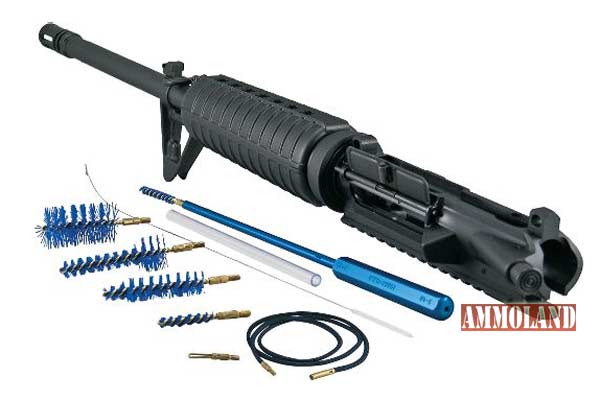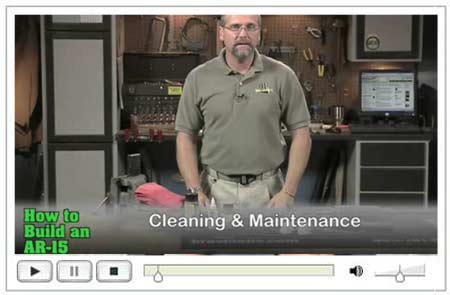Cleaning the AR-15 Rifle
A gunsmith’s recommendations to keep your black rifle clean and operational.
By Steve Felgenhauer


Manasquan, NJ –-(Ammoland.com)- As a gunsmith I clean a lot of rifles.
I also fix a lot of rifles caused by improper cleaning; most of which are not permanently detrimental to the rifles or their accuracy, but each year I get a few rifles that are reduced to wall decorations.
If you ask 10 different shooters how they clean their AR rifle chances are you will get 10 different answers. Of course, the mechanics will be the same, but the details are different and we all know the devil is in the detail.
I interviewed two different groups of shooters to find out how they cleaned their rifles. Group one consisted of shooters who shoot much more than the average Joe including; competition shooters and shooters who are employed by firearm companies to do nothing but shoot firearms all day…Can that really be a job?
These shooters were adamant about their cleaning procedures – almost ritual like. A certain amount of patches wetted with a solvent or other concoction guaranteed to remove all the copper fouling and liberal amounts of elbow grease followed by dry patches and then neutralized so the solvent doesn’t pit the barrel followed by a patch lubed with oil to protect the bore.
Group two consisted mostly of gunsmiths who described horror stories of over-cleaning or improper cleaning procedures and whom spend little time cleaning their rifles, especially the barrel.
Somewhere in between is a happy medium.
The operation of the AR and its dirty little secret.
When the AR is fired; the gases from the ignited powder propels the bullet down the barrel. As the bullet passes over the gas orifice drilled in the barrel a small amount of gas, carbon and other crud travels down the small gas tube to the carrier key which actuates the bolt driving it rearward. Not all this gas, carbon and crud stay in the carrier key of the bolt. A lot of it gets deposited inside the rifle’s action.
I’m not sure who first coined the phrase, “The AR pukes on itself” but I can think of no better way to describe it. With as much crud that builds up inside the rifle it is a surprise it works as well as it does.
Cleaning the AR Style rifle – A method to the madness
The military teaches the newest of recruits to disassemble and reassemble a rifle using a systematic method. It is a good idea to employ this tactic in your cleaning.
Disassembling the rifle, I keep the groups together and as I disassemble these groups further, I place the parts on the bench from left to the right in the order they are removed from the rifle. When reassembling; the reverse order is used. This ensures no part is missed while cleaning or reassembling and is a good time to look for worn or broken parts.
I’m not going to go into the actual cleaning procedure as this is well documented on several video series like the ones from Brownells.

How much to clean
This question always resonates with me. I feel the amount the rifle is used and how it is used should dictate how much to clean your rifle.
If you are set up on a prairie dog town and shooting hundreds of rounds per day, detail cleaning the rifle, daily, to include a thorough barrel scrubbing should be considered SOP, the same with match shooting where precision bullet placement is crucial.
However, if you are going through a 5 day training class or casual plinking, I would punch the bore with a dry patch after each day afield removing any obvious build up from the inside as well as wiping down the exterior of the rifle.
If hunting with a black rifle, I would not punch the bore or use any petroleum product on the rifle until I was finished hunting for the season unless moisture became an issue.
Long term storage, anything more than a month, demands thorough cleaning of the rifle followed by an application of a protective coating like RIG or Cosmolene. Just remember to remove any thick preservative before the next shooting session.
Tools for cleaning
The simple design of the Modern Sporting Rifle makes cleaning and the tools needed fairly straight forward.
The cleaning rod – The cleaning rod should be a one piece rod coated with nylon or plastic sheath or made of brass. Stick with one manufacturer when choosing your cleaning rod. There is nothing more frustrating than digging through a drawer full of brushes, jags and eyelets that don’t fit the cleaning rod when you are trying to clean your rifle. Avoid the military sectional rods if possible; the sections bend easily and the steel on steel does a rifle bore no good.
Many shooters like a long shafted cleaning rod and a shorter coated rod with a “T” handle for cleaning the chamber and locking lug area.

- AR-15 CLEANING ROD GUIDE
The Bore guide – A bore guide as the name implies keeps the cleaning rod centered in the action and bore of the barrel. This eliminates the chance of scratching the rifle’s chamber or bore. If you are not using a bore guide, start!
Brushes – To clean the AR two types of brushes are advised. The chamber brush and the bore brush. The brushes should be made of phosphor bronze and the body of the brush of brass as should be the couplers. The chamber brush is used to clean the barrel extension which can pack full of crud and unburned powder which can prevent the bolt to close causing misfires.
The bore brush should match the bore diameter of the barrel. It is certainly a good idea to change bore brushes every six months, more if you tend to clean your rifle habitually. Check the Ar-15 Brush Pak
Standard issue AP (all purpose) brush – There’s nothing better to get into hard to reach places.
Patches – I’ve used some unlikely items for cleaning patches but to keep a rifles barrel in tip top shape I like uniformity in my patches, Too thick and they get stuck in the barrel, too thin and they won’t do a thorough job. As I write this, Brownell patches sit on my bench. They are sized properly both in size and thickness without trimming and only rarely do I stick one.
Solvents – So many solvents so little time.
I prefer a solvent designed for a specific purpose; copper solvents to remove copper build up and a powder solvent for general cleaning. I’ve used many different kinds and can’t say one is better than another. I have seen some copper solvents pit the bore so now I dry the bore and neutralize it with several patches wetted with denatured alcohol followed by several drying patches and finally a patch wetted with a light coat of oil like Hoppes.
Powder solvents are much the same; they all perform equally, but I do like the idea of a more green friendly approach as much for my well being and wear and tear on my hands as for the environment.
The new spray cleaners are very handy especially for a quick clean. Just spray the solvent, let it loosen the crud and then spray it out again.
One word of caution! When using any solvent on painted firearms especially the wildly popular camo finishes, either factory or after market, always test the solvent in an inconspicuous place like under the handguard. Some of these solvents can unknowingly double as a paint remover, I’ve seen firsthand these “Safe for all Finishes” solvents strip paint and coatings.

Other tools that make cleaning less of a pain
The Rail Vise (www.railvise.com) is a modular holding fixture designed to hold black rifles. It features extruded aluminum bases and molded polymer clamping adapters.
I like the Sinclair AR-15 lug recess cleaning tool to clean out the stubborn locking lug area. This tool, made of Delrin puts a cotton patch deep into the recess of the lug and cleans out the crud you cannot reach with a standard AP brush.
Holding fixtures like the Brownells Lower Receiver Holding Fixture Block is placed in a vice while allowing the rifle owner to use both hands to clean the rifle, however, the upper gets a little wobbly while in the holding fixture. To prevent this, the Sinclair AR-15 Rod Guide and Link Kit keeps the two halves locked together all the while allowing access to the barrel and the inside of the rifle.
The Brownells Handguard Tool is also handy if your AR style rifle is equipped with a delta ring. Simply insert the tool around the delta ring, place the lever point in the magazine well and press down on the delta ring. Brownells feature a video of how to use this and many other tools on their website.

Cleaning a rifle will never be as much fun as shooting it, but with a little common sense and the same amount of elbow grease on a regular basis your shooter will remain that way.
About Steve Felgenhauer:
Steve Felgenhauer is an up and coming freelance writer that focuses on writing about all things firearms – from product reviews to hunting and everything in between. Steve is a frequent contributor to AmmoLand Shooting Sports News. You can read more about gun writer Steve Felgenhauer on the following page.
